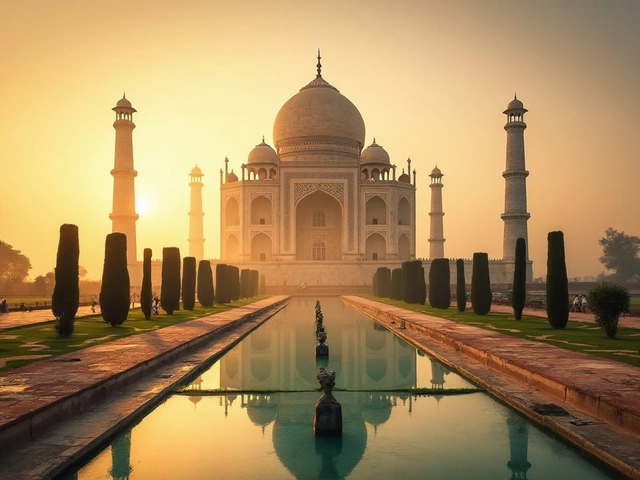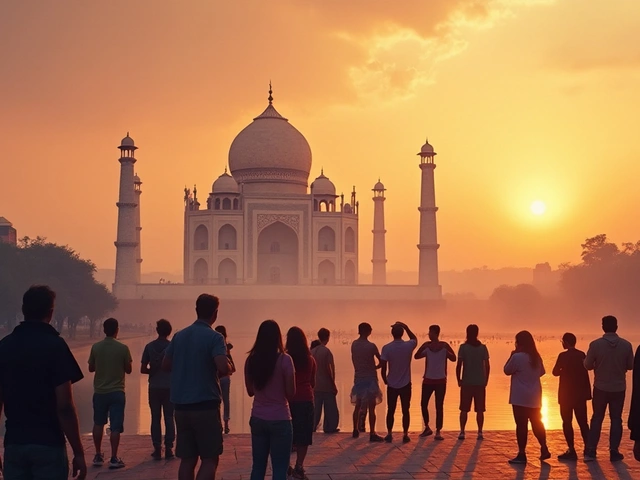Route 66 Trip Duration Calculator
Your Recommended Trip Duration
Recommended- Best Seasons: Spring and fall offer comfortable temperatures
- Must-see stops: Blue Whale of Catoosa, Cadillac Ranch, Grand Canyon
- Car recommendation: Midsize sedan or restored 1960s convertible
When you think about a classic American adventure, the image of a vintage car cruising endless horizons, neon signs flickering in the night, and diners serving pie on the side of the road instantly pops up. That feeling belongs to a single highway that has become a cultural legend - Route 66. If you’re hunting the most iconic road‑trip destination in the United States, this historic route outshines every coastal drive, desert stretch, and mountain pass.
What Makes a Road Trip Destination Iconic?
Iconic isn’t just a buzzword; it’s a blend of history, scenery, pop‑culture presence, and the freedom it offers travelers. A road worth remembering usually ticks these boxes:
- Legacy: Decades of stories, songs, and movies that keep it alive in the public imagination.
- Variety of Landscapes: From deserts to forests, coastlines to rolling farmlands - a single drive should feel like a mini‑tour of the country.
- Accessible Stops: Small towns, quirky museums, iconic diners, and natural wonders that invite spontaneous detours.
- Community Spirit: Locals who preserve the route’s character and welcome travelers.
Route66 checks every one of these, which is why it consistently tops lists of must‑drive highways.
Route66 - The Mother Road
Route 66 is a historic U.S. highway that originally ran from Chicago, Illinois, to SantaMonica, California, covering about 2,448miles (3,940km). It was commissioned in 1926 and became the primary artery for westward migration during the Dust Bowl era. Over the decades, Route66 has appeared in movies like “The Grapes of Wrath,” songs such as “(Get Your Kicks on) Route66,” and countless photo‑books, cementing its status as a symbol of freedom and exploration.
The modern traveler experiences a blend of nostalgic charm and natural beauty. Highlights include:
- Chicago to St.Louis: Start in the windy city’s bustling downtown, cross the iconic Gateway Arch, and feel the Midwest’s open plains.
- St.Louis to Tulsa: Pass through the Ozark foothills, stop at the historic Blue Whale of Catoosa in Oklahoma, and enjoy the quirky roadside art.
- Tulsa to Amarillo: Cruise across the Texas panhandle, visit Cadillac Ranch, and watch the sunset over the high desert.
- Amarillo to Flagstaff: Enter New Mexico’s desert, explore the quirky town of Gallup, then climb into Arizona’s Redwood‑dotted canyons.
- Flagstaff to Santa Monica: Cross the Grand Canyon’s rim, wander through the Mojave Desert, and finish at the Pacific Ocean’s Santa Monica Pier.
The route isn’t a continuous highway any more - it’s a patchwork of state roads, interstates, and preserved segments. That’s part of its charm: you chase the original signs, pop into vintage motels, and soak up local culture along the way.
Pacific Coast Highway - The Coastal Counterpart
Pacific Coast Highway (California State Route 1) hugs the western shoreline from Dana Point in Southern California up to Leggett in Northern California. Stretching about 655miles, it offers breathtaking ocean views, dramatic cliffs, and charming seaside towns.
While it’s visually stunning, the Pacific Coast Highway is a newer road, lacking the deep historic roots of Route66. It’s perfect for travelers who prioritize coastal scenery over nostalgic Americana. Highlights include:
- Malibu’s surf‑capped beaches and celebrity homes.
- SantaBarbara’s Spanish architecture and wineries.
- BigSur’s iconic Bixby Creek Bridge and rugged cliffs.
- Mendocino’s lighthouse and redwood forests.
- The Golden Gate Bridge and SanFrancisco’s skyline.
Both roads deliver unforgettable experiences, but they cater to different moods.
Head‑to‑Head: Route66 vs. Pacific Coast Highway
| Attribute | Route 66 | Pacific Coast Highway |
|---|---|---|
| Length | ~2,448mi (3,940km) | ~655mi (1,054km) |
| Scenic Focus | Midwest plains, desert, historic towns | Coastal cliffs, ocean vistas, redwoods |
| Best Season | Spring & fall (moderate temps) | Late spring-early fall (clear skies, less fog) |
| Iconic Stops | Blue Whale of Catoosa, Cadillac Ranch, Grand Canyon | BigSur, Monterey Bay Aquarium, Golden Gate Bridge |
| Driving Experience | Mix of two‑lane highways, small towns, historic motels | Mostly scenic two‑lane coastal road, winding curves |
For sheer cultural weight and variety, Route66 takes the lead. If you crave endless ocean horizons, the Pacific Coast Highway shines.
Planning Your Route66 Road Trip
Here’s a step‑by‑step plan that keeps the adventure smooth while preserving the “retro” vibe.
- Pick Your Starting Point: Most travelers begin in Chicago because it offers major airports, rental car options, and a vibrant launchpad.
- Map the Core Segments: Allocate 3-4 days for the Midwest, 2days for the Texas panhandle, 3days for the Southwest, and 2days for California’s final stretch.
- Reserve Vintage‑Style Motels: Look for “Route 66 motels” or “retro inns” on booking sites - they often keep original neon signs.
- Pack Essentials: A spare tire, a paper map (cell service can be spotty), and a playlist of classic road‑trip songs.
- Schedule Must‑See Stops: Use the list below to avoid missing the iconic spots.
- Allow Flex Time: The magic of Route66 is the unexpected. Give yourself extra hours each day for roadside attractions.
Must‑See Stops on Route66
The following attractions embody the spirit of the Mother Road. Spend at least an hour at each, unless you’re short on time.
- Gateway Arch (St.Louis, MO): Symbol of westward expansion, offers river views from the top.
- Chain of Rocks Bridge (St.Louis, MO): Historic steel truss bridge open to pedestrians for a dramatic river crossing.
- Blue Whale of Catoosa (Catoosa, OK): A quirky concrete whale you can actually sit inside.
- Cadillac Ranch (Amarillo, TX): Half‑buried 1950s Cadillacs you can paint with chalk.
- Petrified Forest National Park (Arizona): Fossilized wood trunks and colorful badlands.
- Grand Canyon’s East Rim (Arizona): Not the most‑visited side, but offers quiet sunrise views.
- Santa Monica Pier (California): The western terminus - snap a photo with the iconic sign.
Each stop tells a piece of America’s story, from the industrial Midwest to the rugged Southwest.
Practical Tips for a Smooth Journey
Even the most iconic road can throw curveballs. Here are a few pro tips:
- Car Choice: A midsize sedan or a classic convertible works well. If you want to embrace the retro feel, consider renting a restored 1960s car through specialty agencies.
- Timing: Avoid July and August in the desert sections - temperatures can exceed 110°F (43°C). Early May or late September give pleasant weather and thinner crowds.
- Fuel: Fill up whenever you see a station, especially in remote stretches of New Mexico and Arizona.
- Navigation: Download offline maps of each state’s segment. GPS can be unreliable near the Grand Canyon.
- Local Etiquette: Greet small‑town shop owners, leave a tip at the classic diners, and respect private property signs on historic sites.
Follow these pointers and you’ll keep the focus on the road, not the hassles.
Why Route66 Beats the Competition
After weighing history, scenery, and cultural impact, Route66 stands out as the single most iconic road‑trip destination in the USA. It’s a living museum that still serves as a functional highway, offering a blend of nostalgia and genuine adventure that no coastal drive can fully replicate.
Frequently Asked Questions
What is the total length of Route66?
The historic route stretched about 2,448miles (3,940km) from Chicago to Santa Monica.
Do I need a special passport or visa to drive Route66?
No special documentation is required beyond a valid driver’s license and, if you’re a non‑U.S. resident, a valid passport and appropriate visa or ESTA for entry.
When is the best time of year to travel Route66?
Spring (April‑May) and fall (September‑October) provide mild temperatures and fewer crowds, especially in the desert sections.
Can I rent a classic car for the trip?
Yes - several specialty rental agencies in Chicago, St.Louis, and Los Angeles offer restored 1950s‑60s models. Book early, as availability is limited.
What are the must‑see roadside attractions?
Highlights include the Blue Whale of Catoosa (OK), Cadillac Ranch (TX), Petrified Forest (AZ), and the iconic Santa Monica Pier (CA). Each offers a unique photo‑op and a slice of Americana.


